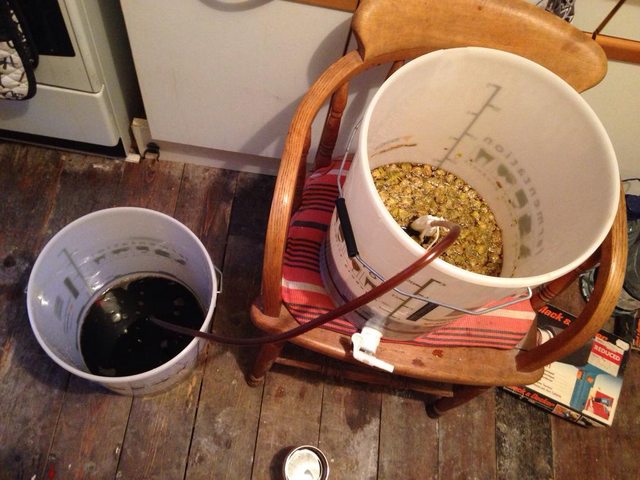rodabod
Member
- Joined
- Feb 13, 2015
- Messages
- 778
- Reaction score
- 220
Hi, this was my first BIAB brew. The recipe was discussed in the recipes discussion section, and I posted it originally to be brewed to 5% or thereabouts.
The beer recipe which I had actually copied was for a session version with a lower grain bill which gave circa 4% for the original brewery. They also offered a "fully leaded" version at circa 7%, and I decided to do this as I had plenty of ingredients and prefer the flavour. The hop recipe is slightly simplified compared to the original brewery's hop schedule.
Anyway, here's what I followed for this brew on last Thursday:
HOME BREW RECIPE:
Title: Black IPA
Author: Roddy
Brew Method: BIAB
Style Name: American IPA
Boil Time: 60 min
Batch Size: 12.6 liters (fermentor volume)
Boil Size: 14 liters
Boil Gravity: 1.059
Efficiency: 75% (brew house)
STATS:
Original Gravity: 1.066
Final Gravity: 1.013
ABV (standard): 7.01%
IBU (tinseth): 78.18
SRM (morey): 18.8
FERMENTABLES:
2.1 kg - United Kingdom - Maris Otter Pale (58.5%)
0.7 kg - German - Vienna (19.5%)
0.35 kg - Flaked Oats (9.7%)
0.35 kg - Torrified Wheat (9.7%)
90.7 g - German - Carafa III (2.5%)**
** 150g extra Carafa III added during sparge as suggested by Clibit.
HOPS:
15 g - Chinook, Type: Leaf/Whole, AA: 13, Use: First Wort, IBU: 19.88
15 g - Citra, Type: Leaf/Whole, AA: 11, Use: First Wort, IBU: 16.82
10 g - Citra, Type: Leaf/Whole, AA: 11, Use: Boil for 10 min, IBU: 6.71
10 g - Mosaic, Type: Leaf/Whole, AA: 12.5, Use: Boil for 10 min, IBU: 7.63
10 g - Nelson Sauvin, Type: Pellet, AA: 12.5, Use: Boil for 10 min, IBU: 8.39
15 g - Citra, Type: Leaf/Whole, AA: 11, Use: Boil for 5 min, IBU: 5.54
15 g - Mosaic, Type: Leaf/Whole, AA: 12.5, Use: Boil for 5 min, IBU: 6.29
15 g - Nelson Sauvin, Type: Pellet, AA: 12.5, Use: Boil for 5 min, IBU: 6.92
15 g - Citra, Type: Leaf/Whole, AA: 11, Use: Dry Hop for 7 days
15 g - Mosaic, Type: Leaf/Whole, AA: 12.5, Use: Dry Hop for 7 days
15 g - Nelson Sauvin, Type: Pellet, AA: 12.5, Use: Dry Hop for 7 days
YEAST:
Fermentis / Safale - American Ale Yeast US-05
Starter: No
Form: Dry
Attenuation (avg): 81%
Flocculation: Medium
Optimum Temp: 12.22 - 25 C
Fermentation Temp: 18 C
Pitch Quantity: 5.75g
My photos are a bit ****, as I wasn't that familiar with BIAB so wasn't sure what I was doing next and when to take any photos.
Hops (Nelson are pellets):
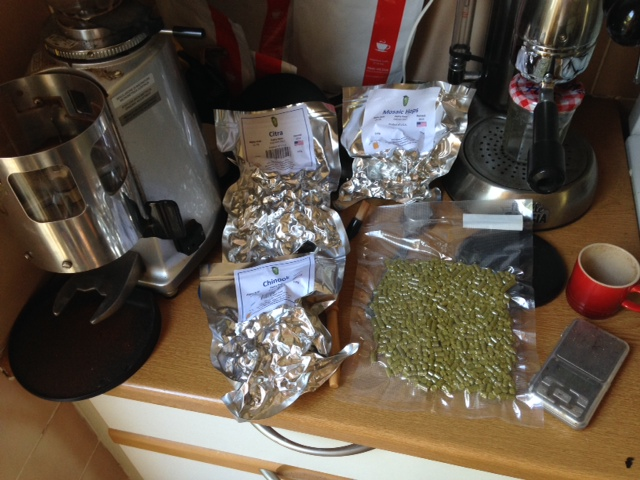
Grains:
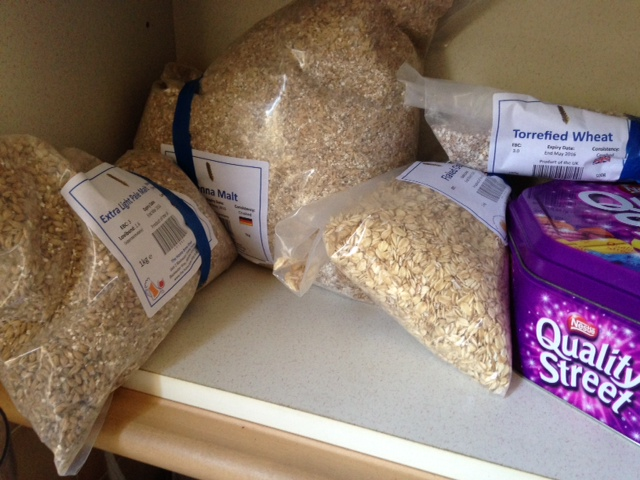
Weighing out Carafa III:
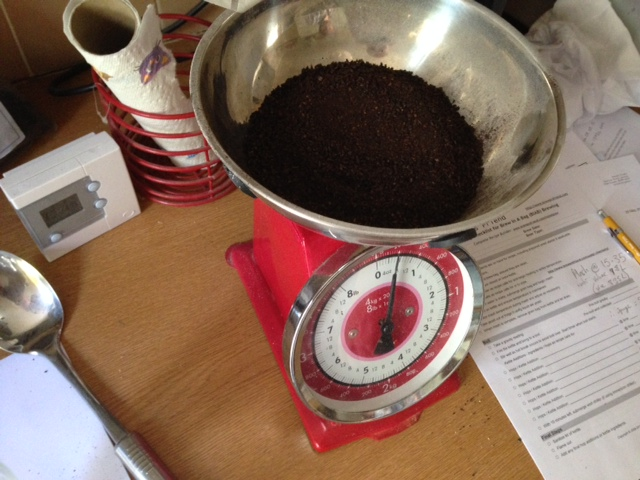
My pan is a 15.2L eBay job. First thing was to get the water (I use Tesco Ashbeck as I live in London and the tap water is foul) up to temperature for mashing. Annoyingly, the online BIAB calculator I used estimated the strike temperature far too low at just a couple of degrees above 67C. It ended up combining to a temperature of 64C, so I had to top-up with boiling.
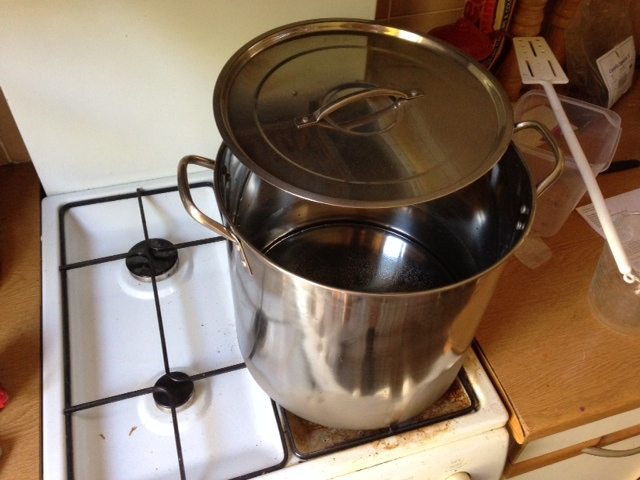
I mash in a plastic fermenting vessel and then wrap in a sleeping bag:
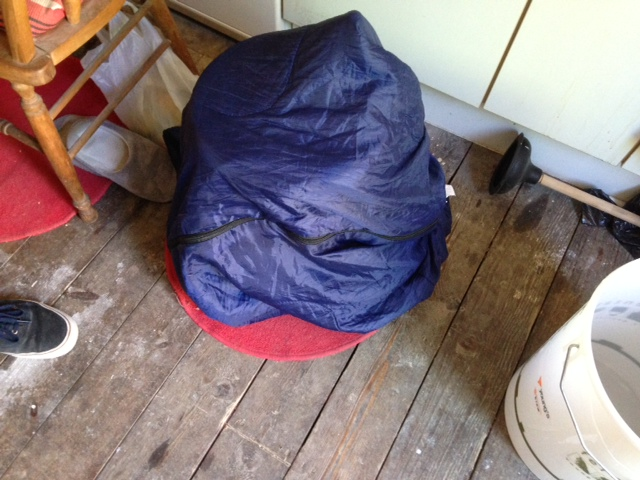
I stir after 30 minutes and check temp. Back down to 64 which was less then I was hoping for (I'd prefer to try to extract more complex sugars for sweetness), so I actually top up with boiling again, and this time give it another 60 minutes (I'd originally just planned an extra 30) as I was paranoid about not achieving great enough efficiency and didn't have iodine to test for conversion.
Bag removed from mash vessel, and it's smelling excellent and tastes lovely, like an extremely sweet Ovaltine.
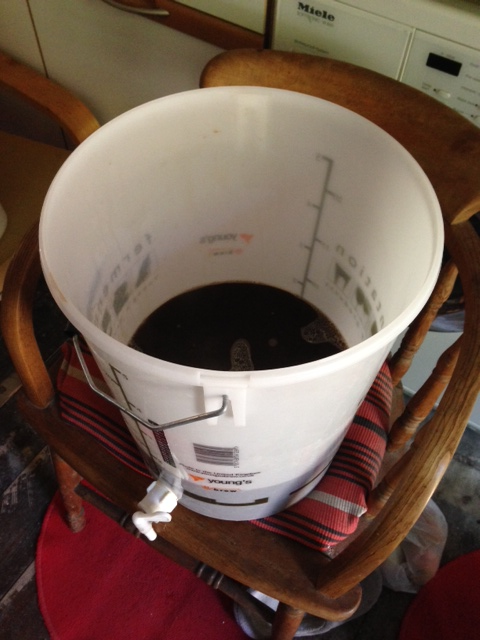
I now heat up some sparge water to around 76C in my pan and dunk the bag with the sticky grains still in it. I also add the additional 150g of Carafa III. I leave the sparge liquor in my pan, and remove the bag to squeeze out. I squeeze it over the mash as its cooler and easier:
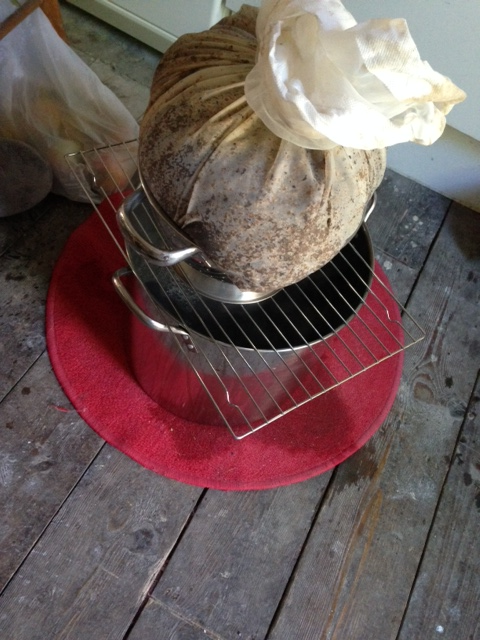
The contents of the mash liquor are then added back to the pan with the sparge liquor in it, and we start to boil:
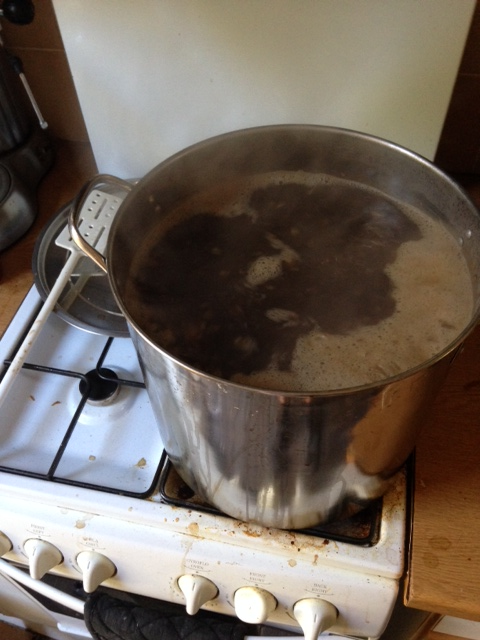
The hops are eventually added, plus an eighth of a tab of protofloc.
All has gone to plan so far, but when I go to siphon the wort through my chiller via a hop filter bag, it just won't go. It's not the hops, but the protein sludge and some hop residue. Eventually I have to run the entire hot work back through a mesh bag to filter it before chilling. I need to correct how this is done next time around.
Anyway, gravity was slightly overshot on the wort, so I watered down slightly to 1064. I will effectively gain a little extra gravity when I bottle ferment.
Steady bubbling starts after 24hrs, and the krausen is maybe only an inch high.
Today (6 days later) I have measured the gravity at 1010. So, I've actually reached a lower gravity than expected. It could be that those lower mash temperatures have led to more fermentable sugars being extracted, however the flavour of the fermented wort is actually nicely sweet, and definitely not dry. Best of all: it's already tasting fairly reminiscent of the beer which I was trying to replicate.
I will report back later with how things are looking when I get around to bottling.
Thanks to forum member Clibit for persuading so many people to try a simple BIAB brew. I maybe wouldn't have tried this otherwise.
Roddy
The beer recipe which I had actually copied was for a session version with a lower grain bill which gave circa 4% for the original brewery. They also offered a "fully leaded" version at circa 7%, and I decided to do this as I had plenty of ingredients and prefer the flavour. The hop recipe is slightly simplified compared to the original brewery's hop schedule.
Anyway, here's what I followed for this brew on last Thursday:
HOME BREW RECIPE:
Title: Black IPA
Author: Roddy
Brew Method: BIAB
Style Name: American IPA
Boil Time: 60 min
Batch Size: 12.6 liters (fermentor volume)
Boil Size: 14 liters
Boil Gravity: 1.059
Efficiency: 75% (brew house)
STATS:
Original Gravity: 1.066
Final Gravity: 1.013
ABV (standard): 7.01%
IBU (tinseth): 78.18
SRM (morey): 18.8
FERMENTABLES:
2.1 kg - United Kingdom - Maris Otter Pale (58.5%)
0.7 kg - German - Vienna (19.5%)
0.35 kg - Flaked Oats (9.7%)
0.35 kg - Torrified Wheat (9.7%)
90.7 g - German - Carafa III (2.5%)**
** 150g extra Carafa III added during sparge as suggested by Clibit.
HOPS:
15 g - Chinook, Type: Leaf/Whole, AA: 13, Use: First Wort, IBU: 19.88
15 g - Citra, Type: Leaf/Whole, AA: 11, Use: First Wort, IBU: 16.82
10 g - Citra, Type: Leaf/Whole, AA: 11, Use: Boil for 10 min, IBU: 6.71
10 g - Mosaic, Type: Leaf/Whole, AA: 12.5, Use: Boil for 10 min, IBU: 7.63
10 g - Nelson Sauvin, Type: Pellet, AA: 12.5, Use: Boil for 10 min, IBU: 8.39
15 g - Citra, Type: Leaf/Whole, AA: 11, Use: Boil for 5 min, IBU: 5.54
15 g - Mosaic, Type: Leaf/Whole, AA: 12.5, Use: Boil for 5 min, IBU: 6.29
15 g - Nelson Sauvin, Type: Pellet, AA: 12.5, Use: Boil for 5 min, IBU: 6.92
15 g - Citra, Type: Leaf/Whole, AA: 11, Use: Dry Hop for 7 days
15 g - Mosaic, Type: Leaf/Whole, AA: 12.5, Use: Dry Hop for 7 days
15 g - Nelson Sauvin, Type: Pellet, AA: 12.5, Use: Dry Hop for 7 days
YEAST:
Fermentis / Safale - American Ale Yeast US-05
Starter: No
Form: Dry
Attenuation (avg): 81%
Flocculation: Medium
Optimum Temp: 12.22 - 25 C
Fermentation Temp: 18 C
Pitch Quantity: 5.75g
My photos are a bit ****, as I wasn't that familiar with BIAB so wasn't sure what I was doing next and when to take any photos.
Hops (Nelson are pellets):

Grains:

Weighing out Carafa III:

My pan is a 15.2L eBay job. First thing was to get the water (I use Tesco Ashbeck as I live in London and the tap water is foul) up to temperature for mashing. Annoyingly, the online BIAB calculator I used estimated the strike temperature far too low at just a couple of degrees above 67C. It ended up combining to a temperature of 64C, so I had to top-up with boiling.

I mash in a plastic fermenting vessel and then wrap in a sleeping bag:

I stir after 30 minutes and check temp. Back down to 64 which was less then I was hoping for (I'd prefer to try to extract more complex sugars for sweetness), so I actually top up with boiling again, and this time give it another 60 minutes (I'd originally just planned an extra 30) as I was paranoid about not achieving great enough efficiency and didn't have iodine to test for conversion.
Bag removed from mash vessel, and it's smelling excellent and tastes lovely, like an extremely sweet Ovaltine.

I now heat up some sparge water to around 76C in my pan and dunk the bag with the sticky grains still in it. I also add the additional 150g of Carafa III. I leave the sparge liquor in my pan, and remove the bag to squeeze out. I squeeze it over the mash as its cooler and easier:

The contents of the mash liquor are then added back to the pan with the sparge liquor in it, and we start to boil:

The hops are eventually added, plus an eighth of a tab of protofloc.
All has gone to plan so far, but when I go to siphon the wort through my chiller via a hop filter bag, it just won't go. It's not the hops, but the protein sludge and some hop residue. Eventually I have to run the entire hot work back through a mesh bag to filter it before chilling. I need to correct how this is done next time around.
Anyway, gravity was slightly overshot on the wort, so I watered down slightly to 1064. I will effectively gain a little extra gravity when I bottle ferment.
Steady bubbling starts after 24hrs, and the krausen is maybe only an inch high.
Today (6 days later) I have measured the gravity at 1010. So, I've actually reached a lower gravity than expected. It could be that those lower mash temperatures have led to more fermentable sugars being extracted, however the flavour of the fermented wort is actually nicely sweet, and definitely not dry. Best of all: it's already tasting fairly reminiscent of the beer which I was trying to replicate.
I will report back later with how things are looking when I get around to bottling.
Thanks to forum member Clibit for persuading so many people to try a simple BIAB brew. I maybe wouldn't have tried this otherwise.
Roddy




